The Generation with no Mountain God: Thoughts on Design and Technology, Sustainable Practice, and Human-nature Co-dependency
Posted on October 26, 2018Today, we live in a world with pressing environmental issues: global warming, depletion of natural resources, and a dramatic decline in biodiversity. We may not directly experience and confront the negative results caused by human activity, but we can certainly feel the stress and the tension in the air as the increasing number of emerging designs and technologies attempt to solve and relieve the environmental stress. The Futures Centres’ report, Future of Sustainability 2018, highlights technological opportunities for the future sustainable development, such as creating autonomous ride-sharing service with renewable energy, regenerative agriculture, and new retail model. However, the critique on the modern human-nature relationship is often absent in sustainability-related future agendas. Today’s technology and design industry tend to look for superficial quick fixes for environmental issues by portraying nature as something controllable and tamable. Such approaches, however, fail to touch the root of unsustainability we experience today, which is the loss of reverence for nature.
Recently, I was fortunate enough to find and watch a 90s Chinese documentary called The Passing of The Last Mountain God, which captured the end of a cultural belief—the vanishing concept of treating mountain as a god among Oroqen people (an ethnic group in northern China). Jingfu Meng was the main character of the documentary and the last Shaman (the intermediary between the human and the god) in Oroqen’s religion. After Jingfu died in 2000, the existence of the mountain god was also “dead” as the generation after him lost faith in their religion. In spite of feeling heavy and complicated witnessing the disappearance of an ethnic culture, the concept of the mountain god provides a framework for re/thinking the role of humans within the larger ecological system and the idea of co-dependency. I am curious, if we reposition humans as facilitators and collaborators in relation to other living creatures within the ecological system, how would this idea potentially reframe human-nature relationship and today’s sustainable practice?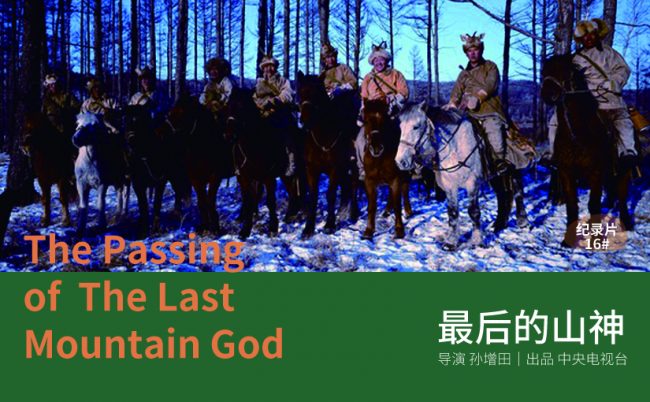
The Existence of the Mountain God and the Human-nature Hierarchy
One of the biggest differences (as I noticed in the documentary) between the Oroqen and the current human-nature relationship is the establishment of different hierarchies, which led to contrasting perceptions of nature and uses of natural resources. Oroqen’s religion suggests there is always a higher hierarchy beyond humans, whereas the modern society instrumentalizes nature.
In the history of Oroqen’s religion, their ancestors were known for historically roaming and hunting in forests. Therefore, their historical dependency on natural resources builds up a culture that is based on the appreciation of nature. The existence of the mountain god can be traced back to the Chinese ancient culture. Due to physical and technological limitations, people could not view the world from a height that is higher than the mountain, The curiosity and the reverence of the world and the unknown later became materialized and evolved into a tangible being—the mountain god. Oroqen people believe all living creatures are spiritual and can be worshipped as gods. Among all gods, the mountain god is one of the most superior and is in charge of the spirit of the mountain, human food and survival, and the overall ecological balance. This belief suggests there is always something above and more powerful than the existence of human beings (graph 1).
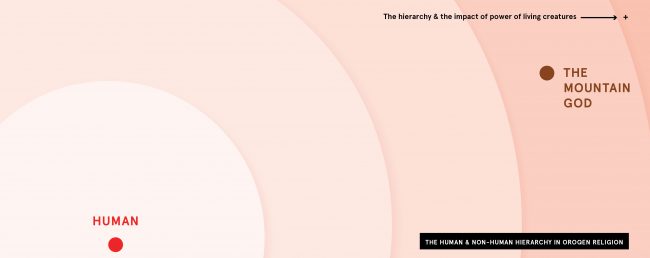
Graph One: The Human & Non-human Hierarchy in Oroqen’s Religion
Jingfu’s interactions with nature were accordingly based on his perception of what nature(the mountain god) wants and the idea of co-dependency. In one scene, Jingfu carefully cut off some tree bark with a knife edge, so he did not cut too deep to “hurt” the tree and also allowed the tree to regrow next year. Jingfu also insisted on using the oldest model of the rifle instead of setting traps to hunt animals, so he could choose to let younger ones go. Jingfu consumed while keeping the nature’s ability to resilient and regenerate in mind, and his intention is simple: “the mountain god would not be happy [if I over-consume].”
Jingfu’s emotional connections and attachments with nature is something I cannot simply imagine as someone growing up in the urbanized and capitalistic culture. The generation I grow up with no longer have this image of mountain gods and the human-nature hierarchy. The modern capitalistic values promote efficiency and productivity to centralize and maximize the satisfaction of human needs and convenience. In capitalism, nature is often seen as a stock of unlimited resources exclusively for human use. The idea of privileging humans among all living creatures narrows the focus of the modern design practice down to humans’ convenience (graph 2).
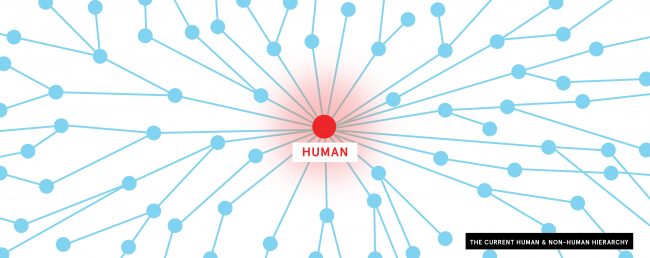
Graph Two: The Current Human & Non-human Hierarchy
his mindset and value seem to legitimize the rationale of continuously perpetuating damaging human behaviors through existing “sustainable” designs, and ironically, opening up new business opportunities. Suddenly, corporations started to use sustainability and new technology as a marketing strategy: “be environmentally friendly by using our newly designed biodegradable plastic cup ❤”; to enable people to continuously use plastic without feeling guilty. The development of design and technology undoubtedly provide advantages. However, it also takes away what is inherent in human nature—the gratitude for precious natural resources that keep us alive.
Sustainability, as I argued here, is a complex issue that cannot be simply tackled by technology. As I am introduced to system thinking, one question that emerged in my thought process is how can we use system thinking, not just as a tool for understanding the complexity of problems, but also a way to trigger internal values, such the appreciation of nature. After reading Some of My Best Friends Are Germs, which suggests the human body is a habitat for microbial species. I think we are basically a small sub-ecosystem within many larger systems (graph three). Similar to the Oroqen’s religion, there is always a bigger system in which human exists and plays a collaborative role in. I suddenly started to feel small thinking from this perspective.
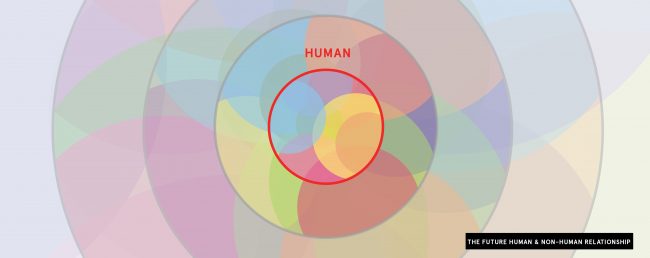
Graph Three: The Future Human & Non-human Relationship
Different from graph two, where humans are presented as an individual entity and are almost opposite to non-human beings, we are actually collaborators and supporters for each other within larger systems, and we are certainly more connected and imitated than we thought. Then why can’t we “invite” other living creatures as a part of the conversation on sustainable design, and design with them? Imagining if people at a sustainable design conference are not coming as representatives of sustainability-related fields, rather as representatives of non-human beings (the representative of coral, the representative of elephants, and representative of air etc.), how would this change the whole dynamic of the conversation? I think the idea of co-dependency in Oroqen’s religion and the “twist” in design mindset can potentially shift how designers conventionally approach sustainable issues and other complex social problems. Speaking from a personal level, I feel I have missed many opportunities of creating stronger bonds with nature growing up in the city after watching the documentary. Therefore, I hope to offer the new generation different moral and ethnical values on building a harmonious human-nature relationship through design, so they can grow up in a way that don’t intrumentalize nature, and see themselves as future collaborators within the ecological system.
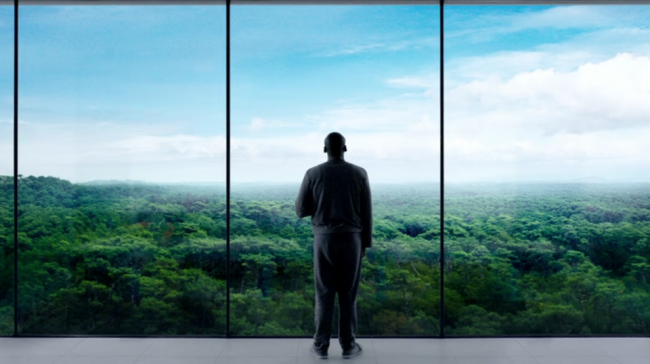
-Danni
————————————————————————————————————————————————————————————————-
References
[1]”Future of Sustainability 2018,” The Futures Centres, accessed Oct 2, 2018, https://thefuturescentre.org/futuresustainability2018/living-in-nonlinear-times/#living-in-nonlinear-times.
[2]Craig Badke, “Critical Inquiry in Design.” In The Handbook of Design for Sustainability (Bloomsbury Publishing 2013), 389.
[3]Suntian Zeng, The Passing of The Last Mountain God,” 1992, video, 28, https://www.bilibili.com/video/av3323538?from=search&seid=15465200764906744897.
[4]”山神到底是个多大的神?” Tianfei Li, accessed Oct 13, 2018, https://media.weibo.cn/article?id=2309404296608819844514.
[5]Jennifer Daniel, Design is Capitalism, filmed October 2015 at CreativeMornings, San Francisco, video, 18:35. https://creativemornings.com/talks/jennifer-daniel/1.
[6]Darrell Posey, Cultural and Spiritual Value of Biodiversity (Intermediate Technology,1999): 25-26.
[7]Anthony Dunne & Fiona Raby, “Beyond Radical Design,” Speculative Everything, 8, The MIT Press, 2013
[8]Michael Pollan, “Some of My Best Friends Are Germs”, accessed Sep 29, 2018, https://www.nytimes.com/2013/05/19/magazine/say-hello-to-the-100-trillion-bacteria-that-make-up-your-microbiome.html